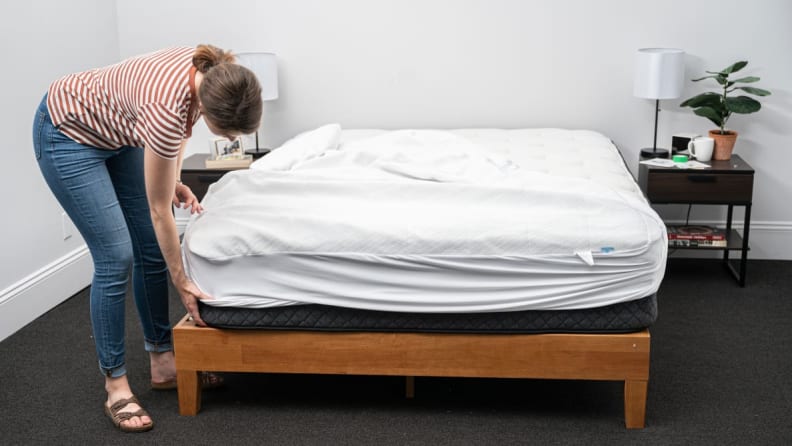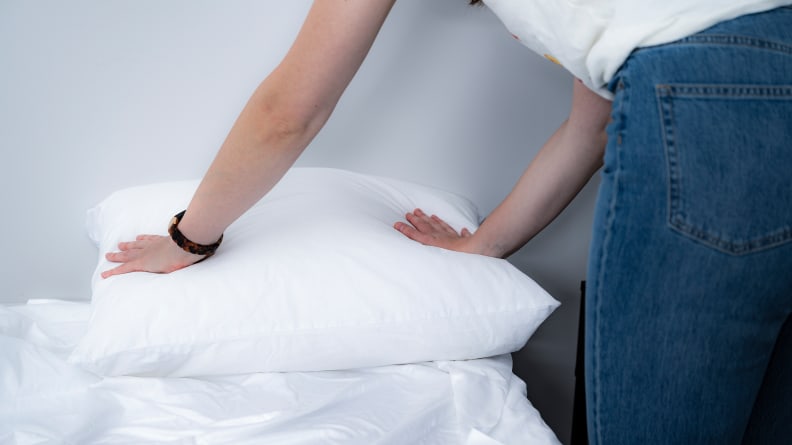Are you making your bed the right way?
No, we’re not talking about how you tuck in the corners and edges.
Products are chosen independently by our editors. Purchases made through our links may earn us a commission.
Making your bed (and storing bed linens) can be a matter of origami—or at least that’s what it feels like. But let’s take a step back to the basics. What are the essential pieces for making your bed, and how can you ensure you’re doing it correctly for the longevity of your mattress, and your health? Read on to find out.
What do you need to make your bed?
Before we talk about how to make a bed, it’s important to acknowledge the essential elements required to make it in the first place. Of course, the core of any bed is the mattress, but there’s more to the story.
1. A mattress protector

The Slumber Cloud Core mattress protector is waterproof and cooling.
You can sleep on the same mattress for as long as 10 years—and that’s a lot of dead skin and drool buildup should your mattress not be properly covered. A mattress protector prolongs the life of your mattress and can keep issues like allergies at bay.
These simple products do what the name implies: They create a barrier between you and your mattress. Many of them claim to be waterproof or water-resistant, meaning spilled liquids or accidents won’t permeate through to the bed. If that’s a high priority, look for a "waterproof" product, as it will prevent liquid from seeping through. “Water resistance” simply means it will take more time for liquid to break through the barrier.
In our review of the best mattress protectors, we loved the Slumber Cloud Core Essential mattress protector because it provides a cooling surface sensation and it’s fully waterproof. When we tested it in our labs, liquids didn’t pool on the surface, but seeped into the quilted top without passing through. (In other words, if you drool or wet the bed, you won’t wake up in a literal puddle on your sheets—the protector will absorb some of it away.)
2. A pillow protector

National Allergy's Allersoft pillow protector is AAFA certified, meaning it met stringent criteria for allergy-proofness.
You can prolong the life of your pillows and keep them cleaner with pillow protectors. They’re simple encasements are composed of a zipper and two pieces of fabric to keep your bed pillow clean and dirt-free longer.
Some pillow protectors confer allergy-protective properties, too, so they will prevent dust mites from building up—and, if they do settle into your pillow, will play a role in keeping them inside the pillow, as opposed to letting them trigger a flare-up. “Many of the guidelines around the world would talk about avoiding triggers as being part of your overall allergy action plan or management plan,” says John McKeon, a doctor who now serves as the CEO of Allergy Standards, a group that provides testing for allergy-proof products. It’s best to implement mattress and pillow protectors when you first buy new products, to decrease build-up of dust mites and allergens.
We tested a bounty of pillow protectors and recommend two options. If you’re looking for allergy-protective properties, consider the National Allergy Allersoft pillow protector. The protector has a certification from the Asthma and Allergy Foundation of America, or AAFA that demonstrates it went through rigorous testing of its material, from multiple wash and dry tests to trials that stretch and pull the fabric in different directions to ensure allergens won’t pass through.
If you aren’t concerned with allergies, we recommend the Brooklinen pillow protector. It’s made of cotton and has a thin profile that’s unnoticeable when added to your pillow. The fabric is smooth and not as prone to staining as many of the others we tested.
3. Bed sheets
Mattress protectors and pillow protectors aren’t meant to be slept on directly—and we’re not sure how they’d perform in those conditions. Therefore, you’ll still need a good set of bed sheets to top it all off.
Sheets also allow you to change up how your bed feels on a seasonal basis—flannel sheets are cozy for winter and fall, while crisp cotton sheets can be a stellar option for warmer months. Having two or more sets on hand makes it easier to cycle through the bedding, as you can have one set washed and ready when you strip the bed.
While it might seem like a hassle or unnecessary, using a top sheet—sometimes called a flat sheet—between your fitted sheet and any blankets will also help keep your bedding clean. If you don’t use one, you’ll be in direct contact with your comforter or blanket, which will make those prone to getting dirtier faster. Often this bedding is harder to wash, creating a whole new type of headache and unnecessary laundry. (Which isn’t to say top sheets eliminate the need to wash blankets, just that they mean you won’t have to launder this bedding as frequently.)
4. A duvet cover
Some folks use duvets—a.k.a. comforters—atop the bed without an additional fabric buffer. It’s far better, however, to give your duvet a layer of protection and use a duvet cover. This is especially true given that most duvets aren’t easily machine-washable. In fact, if you use a down duvet, it’s more than likely the label reads “dry-clean only,” but even this process can cause the filling to degrade over time. Instead, it’s best keep it protected with a washable duvet cover while in use during winter months and to clean then stow your duvet in a breathable bag during the off season. An added bonus? You can switch out your duvet cover to change up the entire look of your bedroom.
How often should you wash your bedding?
Making the bed with all the right equipment is only half of the story—you also need to treat your bedding well to get the most out of it.
Unfortunately for the lazy among us, this means regularly washing your sheets, mattress protector, and pillow protectors. The general recommendation is to wash your sheets every week to two weeks. Washing only your pillowcase more frequently might seem like a good idea, but it doesn’t actually help, as the clean pillow will pick up dirt from other bedding.
Given sheets are atop your mattress and pillow protector, those base layers don’t need to be laundered as frequently—perhaps once a month or so. Follow label instructions for allergy-proof products and mattress protectors, in particular, to maintain their efficacy and lifespan.
What about bed bugs?
There’s one final tip that can improve how you make your bed when it comes to bed bug prevention, and that’s simply to tuck in your flat sheet and any blankets along the sides and foot of the bed. This can help manage bed bugs' access to a cozy mattress, and to you for their blood meals, says Grzegorz Buczkowski, an entomologist at Purdue University. Tucking in sheets will give them fewer ways to climb up to your bed, he explains. While cleanliness is also important, he has found the creatures in settings that range from motels to five-star hotels that change their sheets every day. Mattress protectors, surprisingly, don’t play a role in preventing bed bugs. In fact, he’s seen plenty of infestations on beds with mattress protectors, too.
Fortunately, most people don’t need to worry about bed bugs according to Buczkowski. If you have an infestation, you probably know it. (And if that’s the case, seek out expert help.)
